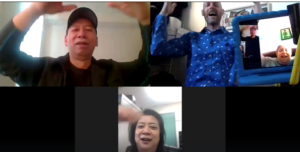
After week one of social distancing I started to think, “Maybe this is what it feels like.” We can’t (easily) leave our homes. We may be reliant on someone else to get our groceries. We’re unable to engage in person with friends or family.
As a Creative Aging practitioner, I know that social isolation has been an issue with older adults long before COVID-19, and will continue to be after. But under “shelter at home” orders perhaps we are all experiencing a taste of what life can be like for older adults, even before this crisis hit.
Making sure that arts programs for older adults provide social engagement opportunities intentionally connected to the art-making is at the heart of Lifetime Arts’ recommendations, supported by important research.
From my own work creating original theater with, and about, the real lives of older adults, I know firsthand that the research is correct. It is the social interaction— the bond built between cast members over the course of rehearsing and putting up a play— or painting side by side in a studio — or singing together in a choir — that is of the greatest physical and mental benefit to older adults. For some, it’s lifesaving, given that social isolation can shorten a person’s life expectancy by 15 years.
So what to do when one “killer” is currently the cure for another, more immediately dangerous one? What is a teaching artist working in this field to do, when our work is to bring older adults together — creatively and physically — to make art with the very goal of combating social isolation?
Teaching Artists Are Figuring Out How to Foster Connection During COVID-19
Formal and informal online classes now abound for all ages. Hop into a Zoom writing class, follow along with an artist streaming work live on Facebook, take a dance class via Instagram. That works well for older adults who are already comfortably using web-based meeting apps and social media, but it is important to acknowledge that the digital divide is a barrier for many (and not just older adults.)
According to Pew Research Center’s “Tech Adoption Climbs Among Older Adults” (May 2017), 67% of older adults (65+) use the internet. While that’s a huge improvement on the past, that demographic skews to the younger, more affluent end of the spectrum.
This study also revealed that older adults often feel intimidated by technology and need help from others to get online (48% of seniors agreed with the statement: “When I get a new electronic device, I usually need someone else to set it up or show me how to use it”). Of course, now is the moment where younger people are assisting older relatives (who need help) to get online, but that support is often hampered by the fact that one can’t safely provide that assistance face to face.
Then a Facebook post from my friend (and teaching artist) John LeoNimm popped up on my feed:
‘Hive mind: help! Video conferencing solution for an online clown course (taught by me) for my students who are older adults: GO!’
And later:
‘Anyone have a way to get FaceTime and Android to talk to each other?? One participant can’t download an app on her iPhone (no Apple ID) but she can do FaceTime … (and others have Androids).’
John had started a clown class at a Brooklyn senior center in January, and was responding to the citywide shutdown by finding ways — any way — to keep his students connected and working. And I thought, “Of course, teaching artists would already be trying to figure this out.” Here was Creative Aging happening “on the front lines” so to speak. As a teaching artist working in this field, you figure out how to solve the immediate problem — get your students access to the art-making experience first —however you can.

John’s journey to move his class online wasn’t easy, but suffice to say, he was determined, and one month later, he has half his original students taking part in a Zoom clown class every week — with a new student who wasn’t a part of the live class joining in after seeing mention on the senior center’s Facebook page.
In between classes, John sends texts, funny gifs, and short comedy videos to keep everyone learning, laughing and also connected. Even on Zoom, John and his students are learning new skills, and it’s clear from his videos that friendships are being born and strengthened — a pretty incredible feat during this time of social distancing.
One student said:
“I get to express myself and laugh. It feels sooo good to laugh! Also, It’s so great to be able to see my friends from the center.”
I found this example so joyous when joy is in such limited supply right now.
Let’s All #ConnectThruCreativityNow
We’ve decided to launch a campaign at Lifetime Arts called, “Connect Through Creativity,” highlighting teaching artists arts, community, and senior service organizations across the country who are diving in, like John, to this brave new world of Creative Aging during COVID-19.
We will be using the #ConnectThruCreativityNow hashtag on our social media posts, and encourage teaching artists and others to submit their own stories, too.
There are no perfect guidelines for this, no exact science. While in-person programming will always be preferred, right now it’s vital make every effort to ensure that social distancing doesn’t increase feelings of isolation.
In fact, this campaign aims to inspire everyone to reach out. Call an older adult — one you’re related to or not — and just talk, chat about a book, listen to music together, maybe sing, if the spirit moves you. Engaging social connection is the best medicine for these times, and will continue to be, even when we can all meet up again.
#ConnectThruCreativityNow Campaign
Like many arts service organizations, Lifetime Arts is recalibrating its offerings to best suit the circumstances surrounding COVID-19. #ConnectThruCreativityNow is just one of the things that we are doing to advocate for continued artistic and social engagement for older adults while under quarantine.
Share Your Story
Tell us how you are reaching out to older adults during this time. Thank you!


